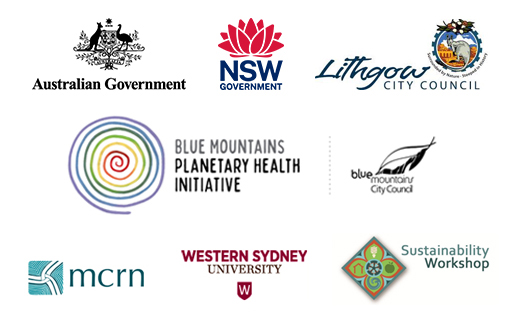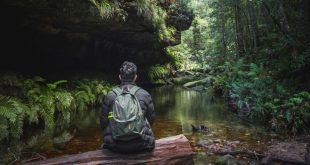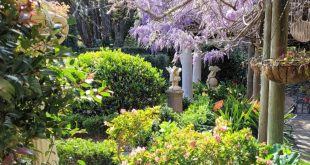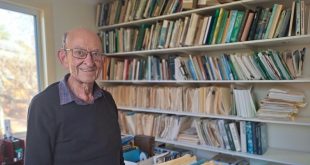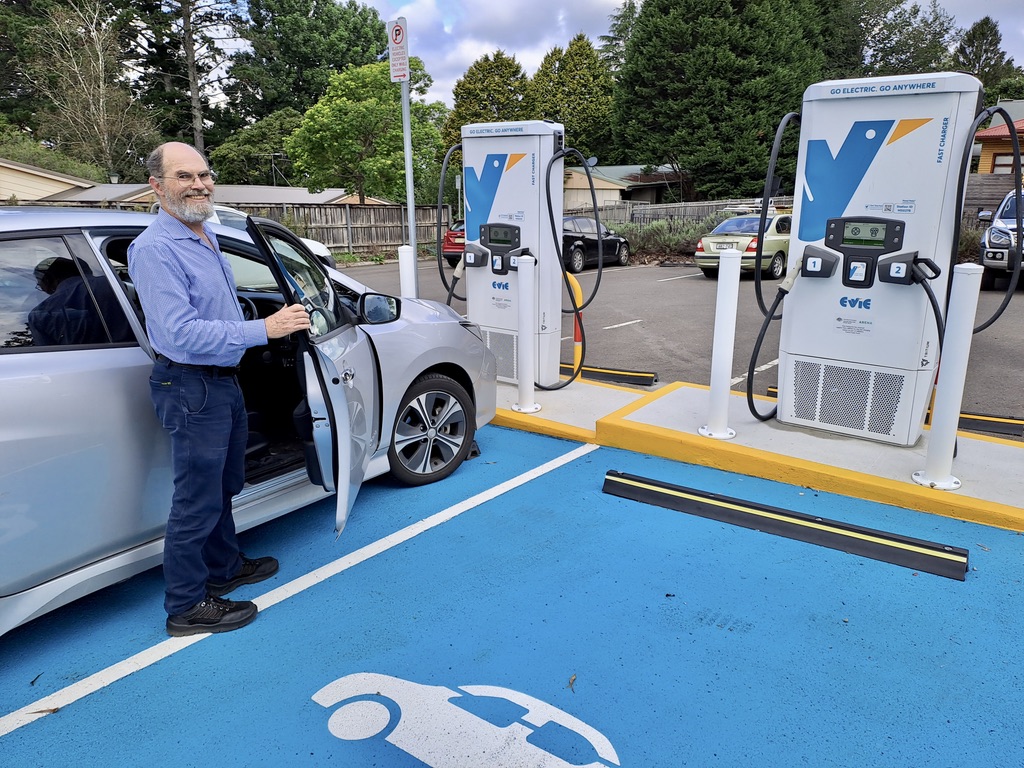
Alan Wardrop recharging his EV in the Council-owned car park in Lawson town centre (Belle Butler)
By Belle Butler
Cars are something I know very little about. Ours generally exists in some state of shameful kid-induced, post-cyclonic chaos. If there is room to sit in the back seat, you need to shift a pile of abandoned ‘toys’, check for yesterday’s apple core and mind the crease of food crumbs in the upholstery. Your feet rest on a mishmash of discarded shoes, more ‘toys’ (my daughter, who is the culprit here, has an interesting idea of what a toy is – often a piece of cardboard stolen from a food box and transformed into something now utterly essential to KEEP). There are drink bottles thought to be left at school, old school notes (never received), and beneath it all a decent sample of earth from various locations. If you are unlucky, yesterday’s apple core turns out to no longer be from yesterday. I blame the kids, but I did just spend a decent chunk of time wiping my own melted lipstick off the interior AND exterior of our car (how it travelled so far, nobody knows… kids!). It took my husband copping a smear of it on his work pants (oh dear) for me to finally deal with it.
When I take our (poor, neglected) car to the mechanic I use terms like ‘thing-a-me-jig’ or ‘whose-y-what’s-it’. When he describes in full detail the magic he has performed on my vehicle I look at him as if he is a wizard.
The inner workings of a combustion engine are actually quite simple. I called my wizard-mechanic, Stephen Smith, to find out how it works and he explained it in terms I could understand. Air is sucked into the combustion chamber and squeezed by a piston, then fuel is injected into the chamber where a spark plug ignites it and creates a mini explosion, which forces the piston down and produces energy. It’s a clever invention that has changed our lives dramatically, for better and for worse. One of the main problems is, of course, the need for fossil fuels to create that little explosion that propels us through our daily lives, and the CO2 emissions released as a by-product.
In Australia, where we are heavily dependent on cars, transport is the third biggest source of greenhouse gas emissions, and cars are responsible for about half of that output (See: FactSheet-Transport.pdf (climatecouncil.org.au) A natural balance of greenhouse gasses in the atmosphere makes the earth liveable by trapping some of the sun’s heat and radiating it back to the ground. But by pumping more and more greenhouse gasses – like the exhaust from internal combustion engines – into the mix, we have created an imbalanced atmosphere that traps too much of the sun’s warmth and results in global warming.
The Climate Council notes that increasing the use of public transport is a key factor in reducing emissions. Here in the Blue Mountains we are lucky to have a train line connecting our towns. However, where public transport isn’t an option, another solution to tackling car-related emissions is switching over to electric vehicles (EVs). EVs do not require the individual consumption of fossil fuels to run. They are powered by electricity, which, acknowledged here, is still mostly sourced by burning fossil fuels. However, EVs are a certain way of reducing transport-related emissions, especially if paired with renewable energy, such as recharging via solar power.
Bullaburra resident, and long-time EV advocate Alan Wardrop, switched over to an EV Nissan Leaf two years ago and has no regrets. He took me through the mechanics of it all. A modern EV uses an inverter to make the motor run. The inverter draws in direct current (DC) from the battery and converts it to alternating current (AC). This is used to power electromagnets which make a rotating magnetic field in the motor. The speed of the motor is controlled by the frequency of the AC current. I had just got my head around the inner workings of an internal combustion engine, now my mind was well and truly blown.
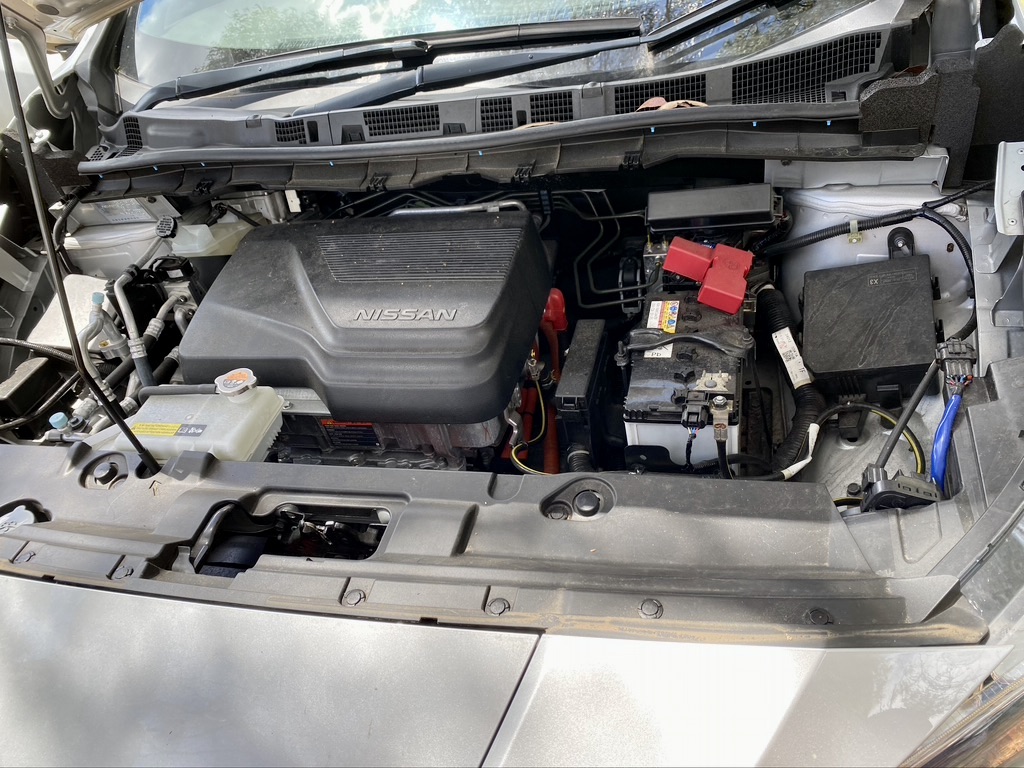
Looking under the bonnet of Alan’s EV (Lis Bastian)
Alan’s enthusiasm for the mechanics of EVs came from his electrician father. “Motors were not uncommon around the house,” he said, recalling that he and his father were discussing the possibilities for electric vehicles back in the 1970s. “He would have been very impressed with all our new technology.”
While the technology involved in running an EV is of particular interest to Alan, he noted the environmental impact of reduced emissions as a significant factor in his decision to buy one. He also cited positive side-effects of driving one: without the need for petrol and exhaust, there is no unpleasant smell; quick acceleration from zero-up is handy for finding a gap and entering higher-speed roads; and a regenerative braking system recharges the battery while the brake pedals are pressed. “Ideal for the Blue Mountains, with all our hills,” he said.
Another enthusiastic EV owner, Carolynne Skinner of Wentworth Falls, also takes pleasure in the zippy acceleration of her second-hand Nissan Leaf. “Oh it’s fun,” she said, of driving an EV. “It’s great fun at the traffic lights, when you’re sitting there at the front and then suddenly, off you go and disappear over the horizon. People think ‘what’s that little old lady doing?’ Then they realise I’m in an electric car!”
More affordable second hand cars through The Good Car Co
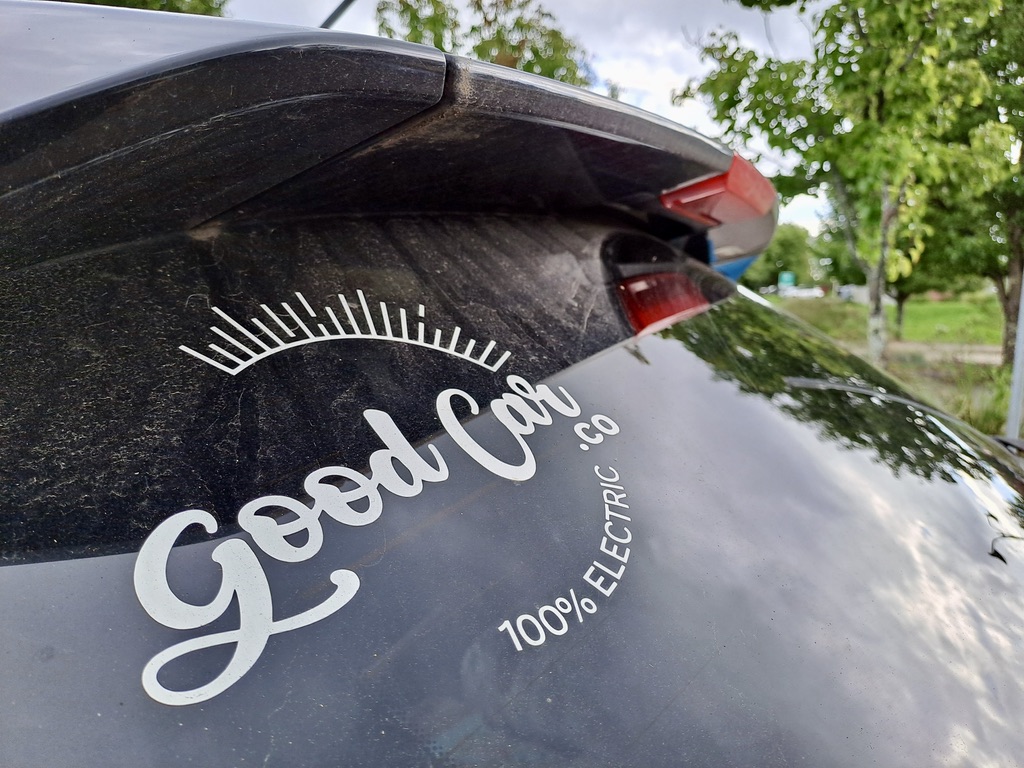
Both Alan and Carolynne’s cars were purchased from the Good Car Co (Belle Butler)
Noting the potentially prohibitive factor of the cost, Carolynne raved about her experience of purchasing hers second-hand through The Good Car Company. Alan also purchased his through this company, which was founded by three environmental scientists, aiming to reduce carbon emissions by thousands of tonnes. They do this by bulk-buying used electric cars from Japan and on-selling them in Australia at more affordable prices than their new equivalents. Their current models range from around $19,000 to $60,000.
For Carolynne this meant buying an EV was a viable option. “I had a long term plan,” she said. I saved up for solar panels, and as soon as I got my solar panels, I got my car. I think that every family should have a project like that. Apart from anything, it’s fun.” Carolynne believes in the individual’s capacity to make a difference and wishes more people would invest in a solar-EV combo, as she has done.
A local recharging network
While charging an EV at home via solar energy is the ideal, EV drivers can now plug in at a re-charging station in the Council-owned car park off New Street in Lawson town centre. The installation of the Evie Networks charging station was welcomed by Blue Mountains City Council last year. Announcing the project in June 2022, Mayor Cr Mark Greenhill said: “This is another exciting opportunity for the Blue Mountains – both for local residents and the many visitors to our region, to help us encourage and facilitate the uptake of electric vehicles, by reducing range anxiety and eliminating barriers to their uptake.” Six electric vehicle stations are also being installed at the Hope Street carpark, Blaxland.
“Hopefully this will be the start of a network of EV charging stations across the Blue Mountains, aligning with our vision for a more sustainable, accessible, healthy and liveable City. Encouraging EV owners to visit the Blue Mountains will also provide a boost to our local economy.”
Mayor Cr Mark Greenhill
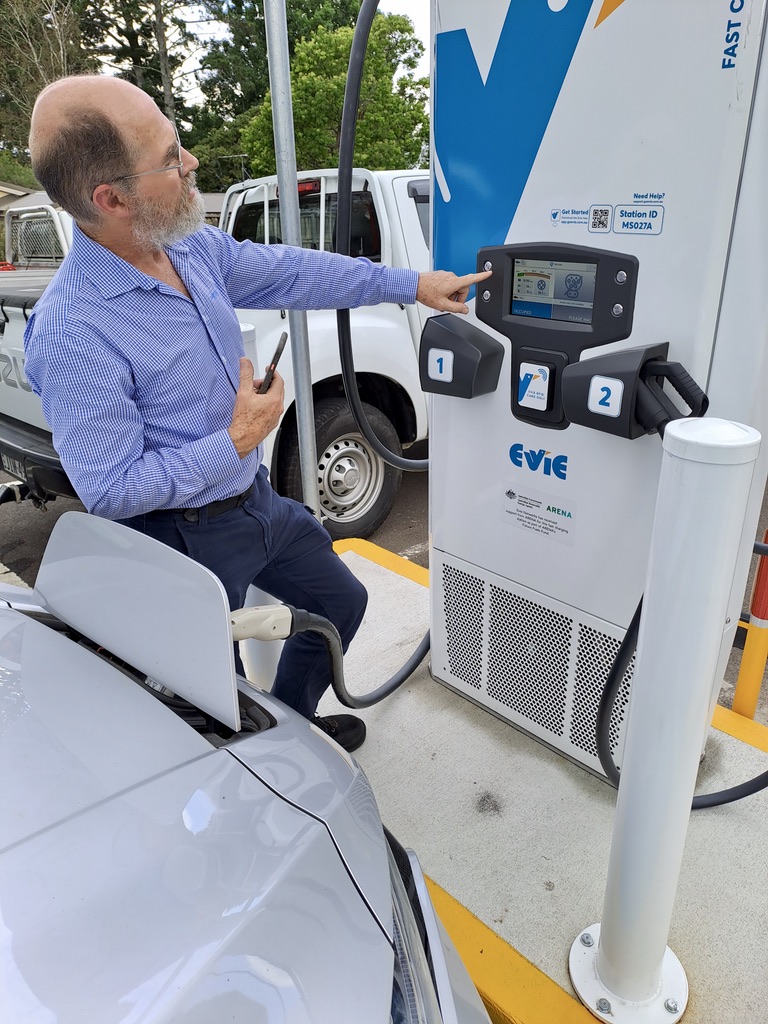
Alan charging his EV in Lawson (Belle Butler)
Alan echoed the Mayor’s sentiment, hoping that charging stations will be installed in each entry town to the Blue Mountains as well as the major shopping areas of Springwood and Katoomba.
“It’s great for business. Sometimes I use the time to do my shopping while I wait for the car to charge, then it just lets me know when it’s done [via phone notification].”
Alan Wardrop
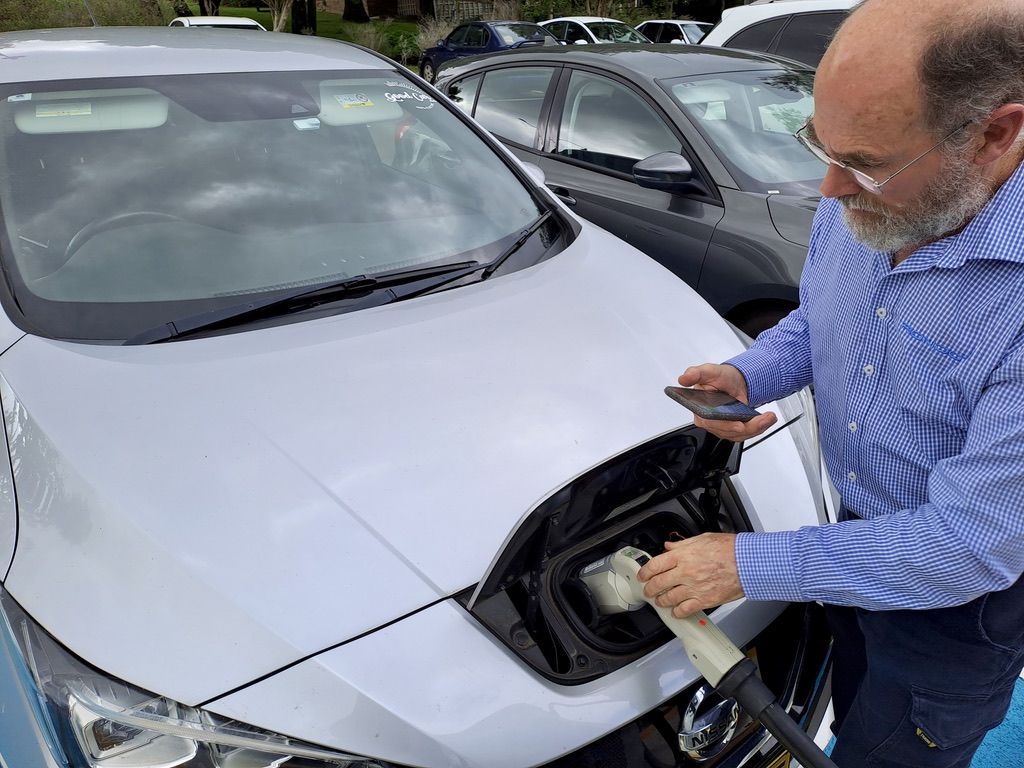
Alan timing the charge for his car (Belle Butler)
For Lawson businesses it is an obvious boon. Charging can take anywhere from 15 to 45 minutes, leaving drivers with plenty of time to get a coffee or do a quick shop. While my mechanic Stephen may not benefit so directly from the uptake of EVs, he had his own nuanced opinion about it. “Oh, I’m all for them,” he said, “but right now it’s about big companies getting richer. We’ve got so many cars on the road and they’re all just going to go in the bin.”
This conjured up visions of vast metal graveyards. All that waste. Another environmental problem.
“We need to retrofit existing cars with electric technology,” he said. When I asked him if that was possible, he replied, “100%. They’re already doing it.”
Google-searching this option, I did indeed find information about retrofitting old vehicles with EV technology. As a big fan of reuse/re-purpose philosophy, this option appealed to me the most.
In the interest of reducing individual transport-related emissions, public transport is an excellent choice. However, if you must own a car, then jumping into an EV – whether you fancy a new one, buy used, or retrofit an existing vehicle – is a hugely impactful and increasingly achievable option. With charging stations like the one in Lawson becoming more readily accessible, there are fewer barriers to making a seamless transition.
I will, however, recommend leaving lipstick out of the car – the sun may do wonders for powering electric vehicles, but in the case of lipstick ….
Related Stories:
The federal government has released its first electric vehicle strategy and outlined how it plans to remove barriers to buying EVs:
Council explores electric vehicle options:
Blackheath Rotary president provides a glimpse of the future: https://thebigfixblackheath.org/blackheath-rotary-president-provides-a-glimpse-of-the-future/
Retrofitting existing cars: Charles Dalglish’s electric sportscar, Little Hartley:
This story has been produced as part of a Bioregional Collaboration for Planetary Health and is supported by the Disaster Risk Reduction Fund (DRRF). The DRRF is jointly funded by the Australian and New South Wales governments.
